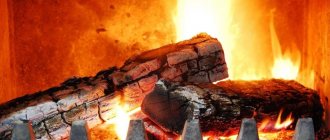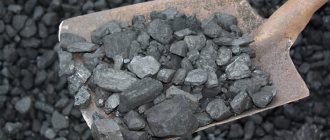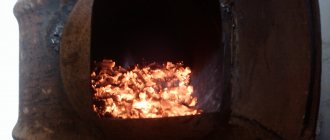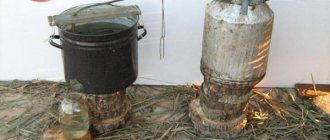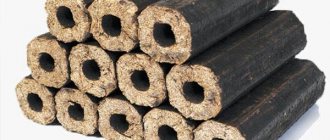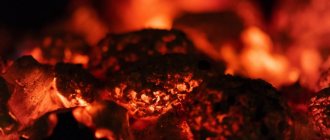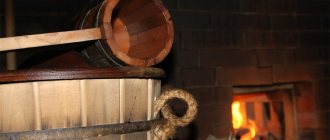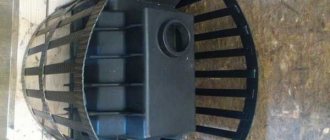Features of different types of fuel
Let's consider the two main, most common types of solid fuel raw materials - firewood and coal.
Firewood contains a significant amount of moisture, so the moisture first evaporates, which will require a certain amount of energy. After the moisture evaporates, intense combustion of the wood begins, but, unfortunately, the process does not last long.
Therefore, to maintain it, regular addition of firewood to the firebox is required. The ignition temperature of wood is about 300°C.
In terms of the amount of heat generated and the duration of combustion, coal is superior to wood . Depending on the age of the fossil material, the mineral is divided into types:
- brown;
- stone;
- anthracite.
What are the main differences in heating systems using coal and wood?
Coal is still a fairly cheap product, and coal boilers are the cheapest of all modern devices. Coal burns slowly, releasing enough heat so that the problem of loading a new batch into the boiler does not bother you too often. Coal boilers can also burn wood, but with less efficiency. Coal in the house is a constant source of dirt. Burning coal is harmful to the environment.
Wood is considered an environmental fuel; when burned, no harmful compounds are formed. The cost of firewood can be very low. However, the price of certain types of wood fuel - briquettes or pellets - is still quite high. Harvesting firewood is a rather labor-intensive and time-consuming process. Wood boilers are more expensive than coal boilers. Modern boilers running on pelletized wood fuel are almost completely automated and do not require special maintenance.
A coal boiler is right for you if...
There is coal mining in your region, or for some other reason, coal is cheap and ordering it is relatively easy. In regions where coal is not traditionally used for heating, the use of such a boiler is completely unjustified. When both coal and wood are available and you are looking for an inexpensive automated boiler, a coal boiler is definitely your choice. Automated boilers for pellets and briquettes are still quite expensive, unlike the same coal boilers
This choice will allow you not to spend a lot of time and effort on loading fuel, which is quite important for a rural resident.
A biofuel boiler is right for you if...
- You prefer cleaner fuel. Having a coal boiler in the house, you have to put up with constant pollution of the space with coal dust. In this case, even purchasing specially prepared portions of coal will not save you. It is clear that cleaning the boiler room is not a priority, not to mention the fact that we breathe this dust, which does not improve health in any way. Even simple firewood that sheds sawdust and bark is much more pleasant to use than coal. Pellets and briquettes do not pollute your home at all and do not emit harmful compounds into the air. Ash from wood combustion, unlike waste from the coal combustion process, is a valuable mineral fertilizer.
- You have access to cheap wood. In the “forest” regions of Russia, getting cheap firewood is not a problem. You can completely minimize costs if you prepare firewood yourself. Each household has the right to receive a plot of firewood once a year for very little money, however, this right is rarely used, since purchasing standing timber involves a considerable expenditure of time and effort. It’s easier to buy already chopped firewood, which will be delivered to your gate. If money is not an issue, then it is better to use pellets or briquettes for heating.
- Your priority is ease of maintenance of your heating system. Although coal boilers are automated, pellet devices are much more technically advanced. Some pellet boilers can be loaded once a week. Lighting such a boiler is quite easy - due to its small size, the granules ignite well. Most boilers are equipped with electric ignition, which is controlled by a controller, a sophisticated air supply system to the burner, and even an automatic device for removing combustion waste.
Composition of different types of fuel
Brown coal is a young deposit, so it contains the largest amount of moisture (from 20% to 40%), volatile substances (up to 50%) and a small amount of carbon (from 50% to 70%).
Its combustion temperature is higher than wood and is 350°C. Heat of combustion - 3500 kcal/kg. The most common type of fuel is coal. It contains a small amount of moisture (13-15%), and the content of the combustible element carbon exceeds 75%, depending on the variety.
The average combustion temperature is 470°C. Volatile gases in coal are 40%. When burned, 7000 kcal/kg is released.
The oldest solid fuel deposits include anthracite, which occurs at considerable depth. It contains virtually no volatile gases (5-10%), and the amount of carbon varies between 93-97%. The heat of combustion ranges from 8100 to 8350 kcal/kg.
Special mention should be made of charcoal. It is obtained from wood by pyrolysis - combustion at high temperatures without oxygen. The finished product has a high carbon content (from 70% to 90%). When burning wood fuel, about 7000 kcal/kg is released.
You can read about the features of using peat briquettes in this article:
Types of coal
There are several types of this fuel; the temperature of coal during combustion will be different for each type. Based on their origin, they distinguish between coal obtained from wood and fossil specimens.
Fossil fuels were created by nature itself. It consists of plant components that have undergone changes while located under the thickness of the earth.
The following types of coal fall into this category::
- anthracite;
- brown;
- stone.
There are 3 types of coal
Natural resources
The youngest type of fossil is brown coal. This type of fuel consists of a large number of impurities and has a high level of moisture (up to 40%). In this case, the carbon content can reach up to 70%.
Due to high humidity, this coal has a low combustion temperature and low heat transfer . The combustion temperature is 1900 degrees, and combustion occurs at 250 degrees. The brown variety is rarely used for stoves in private homes, since it is much inferior in quality to firewood.
However, brown coal in the form of briquettes is in high demand. This coolant undergoes special modification. Its humidity decreases, and therefore the fuel becomes more efficient.
This coal has high humidity.
Stone minerals are older than brown ones. In nature they are found very deep underground. This coolant can contain up to 95% carbon and up to 30% volatile impurities. At the same time, the fossil has a low moisture content - a maximum of 12%.
While in the furnace, the combustion temperature of coal is 1000 degrees , and under ideal conditions it can reach 2100 degrees. It is quite difficult to ignite; to do this, you need to heat the fossil to 400 degrees. Stone coolant is the most popular type of fuel for heating buildings and private homes.
Anthracite is the oldest fossil, practically free of impurities and moisture. The amount of carbon in the fuel is more than 95%. The combustion temperature is 2250 degrees under suitable conditions.
For ignition it is necessary to create a temperature of at least 600 degrees. It is necessary to use firewood in order to create the necessary heating. Interesting: the temperature of burning wood in the stove.
This coal has no moisture
Production products
Charcoal is not a natural resource, so it is classified in a separate category. This product is obtained by processing wood. Excess moisture is removed from it and the structure is changed. When properly stored, the moisture content of wood fuel is 15%.
In order for the fuel to ignite, it must be heated to 200 degrees. It should be taken into account that the combustion temperature of charcoal may differ depending on the conditions and type of wood, for example :
- Birch coals are suitable for forging metal - with a high-quality air supply, they will burn at 1200-1300 degrees;
- in a heating boiler or stove, the temperature of charcoal during combustion will be 800-900 degrees;
- in a barbecue outdoors the indicator will be 700 degrees.
Fuel obtained from wood is very economical. It requires much less than firewood. This industrial product is ideal for cooking meat on the grill.
In this video you will learn the difference between coal and charcoal:
Combustion process
Depending on the type and grade, fuel is divided into short-flame and long-flame.
Short-flame coals include anthracite and coke, and charcoal. When burned, anthracite produces a lot of heat, but to ignite it it is necessary to provide a high temperature with a more easily flammable fuel, such as wood. Anthracite does not emit smoke, burns odorless, and has a low flame.
Long-flame fuels burn in two stages. First, volatile gases are released, which burn above the coal layer in the furnace space.
After the gases burn out, the remaining fuel begins to burn, which has meanwhile turned into coke. The coke burns on the grates with a short flame. After carbon burns out, ash and slag remain.
Coal burning
Underground fires can continue for long periods of time (months or years, in some cases up to several thousand years) until the smoldering layer is exhausted. They can spread over large areas along mine workings and cracks in rock masses. Since they are underground, they are extremely difficult to extinguish, which is not least due to the difficulty or impossibility of access to the source of combustion.
Some coal seam fires are natural phenomena. Some coals may spontaneously ignite at temperatures below 100°C (212°F) at certain moisture contents and lump sizes. Wildfires (caused by lightning or otherwise) can ignite coal lying close to the surface, and smoldering can spread through the seams, creating conditions for deeper seams to ignite. Prehistoric cinder outcrops in the American West are the result of prehistoric coal burnings that left a residue that resists erosion better than the matrix. Scientists estimate that Burning Mountain in Australia is the oldest known burning coal deposit - the fire there has been going on for about 6,000 years.
There are thousands of active, unstoppable underground fires around the world, especially in China and India, where poverty, lack of government regulation and uncontrolled development combine to threaten the environment. Modern layer mining opens smoldering layers of coal to the air, restarting combustion.
Among the hundreds of underground fires in the United States, the most famous is in Centralia, Pennsylvania. It started burning in 1962. Today, other underground fires are active in the United States, for example in the city of Vanderbilt, also in Pennsylvania (the state with the largest number of underground fires).
Underground fires can start as a result of an accident, usually causing a gas explosion. Some underground fires started when authorities blew up illegal mines. Many recent mine fires were started by people burning trash in pits near abandoned coal mines (as happened in Centralia, for example).
China's rural residents in coal-producing regions often mine coal for home use, abandoning mines when they are depleted, leaving the highly flammable coal dust in the open air. Mapping China's coal fires from satellite photography has revealed many previously unknown fires. There are several successful examples of fighting underground fires: in 2004, China managed to extinguish a fire in the Liuhuangou coal mine, near Urumqi in the Xinjiang region, which had been burning since 1874. The worst of the current fires are in the Uda coalfields in Inner Mongolia. China's coal fires burn 20-30 million tons of coal per year. The liquidation of underground fires in mines, as well as the rescue of people in Russia, is carried out by the VGChS
Burning
Let's consider the process of fuel combustion in a conventional stove, which is used for heating private houses. It consists of main parts:
- fireboxes;
- blower;
- chimney with pipe.
The firebox is connected to the blower through a special grate (grids) located at the bottom of the firebox . Fuel is placed on the grate, and air enters the firebox from the ash pan through the grate.
Coal storage
Coal for heating WPC is easy to place on the site and store. Coal can be placed outdoors. It does not get wet and is not afraid of precipitation. Coal is quite heavy, several tons of coal takes up very little space. I dumped the coal in the area and covered it with a tarp to make it easier to get it out from under the snow. Coal is available both in bulk and in bags. In bags it is more expensive, but it is already prepared for burning, chopped into pieces the size of a nut. But unloading these bags can be a problem, whereas bulk coal can be emptied from a dump truck in 2 minutes. In loose coal there are large pieces that then have to be chopped. I chose this option. It’s even fun for me to go out into the frost in the morning and chop coal. I stab him with a cleaver (a kind of sledgehammer, one side of which is made in the form of a wedge)
Combustion formulas
Ignition temperatures of different types of fuel (click to enlarge)
When fuel (wood, coal) ignites, a chemical reaction occurs and heat is released.
Carbon dioxide reacts with the carbon in the fuel in the upper layers to form carbon monoxide.
The combustion process does not end there, because rising up in the combustion space, carbon monoxide reacts with oxygen from the air, the influx of which occurs through the vent or the open firebox door.
Its combustion is accompanied by a blue flame and the release of heat. The resulting carbon monoxide (carbon dioxide) enters the chimney and escapes through the pipe.
Smoldering with minimal oxygen will produce non-poisonous carbon monoxide, producing even heat.
Coal options
The combustion temperature of charcoal is much higher, so this fuel option is an excellent alternative to conventional firewood. We also note the excellent heat transfer rate, the duration of the combustion process, and low fuel consumption. There are several types of coal, related to the specifics of mining, as well as the depth of occurrence in the bowels of the earth: hard, brown, anthracite.
Each of these options has its own distinctive qualities and characteristics that allow it to be used in solid fuel boilers. The combustion temperature of coal in a furnace will be minimal when using brown coal, since it contains a fairly large amount of various impurities. As for heat transfer indicators, their value is similar to wood. The chemical combustion reaction is exothermic, the calorific value of coal is high.
Coal has an ignition temperature of 400 degrees. Moreover, the calorific value of this type of coal is quite high, so this type of fuel is widely used for heating residential premises.
We recommend: Dormer window: what it is, what it is for and why it is needed, purpose
Anthracite has maximum efficiency. Among the disadvantages of such fuel, we highlight its high cost. The combustion temperature of this type of coal reaches 2250 degrees. No solid fuel extracted from the bowels of the earth has such an indicator.
Application
The main use of fuel is to burn it to produce heat.
Heat is used not only for heating a private home and cooking, but also in industry to support technological processes that occur at high temperatures. Unlike a conventional stove, where the process of oxygen supply and combustion intensity is poorly regulated, in industrial stoves special attention is paid to controlling the supply of oxygen and maintaining a uniform combustion temperature.
Let's consider the basic scheme of coal combustion.
- The fuel heats up and moisture evaporates.
- As the temperature rises, the coking process begins with the release of volatile coke gases. When burned, it provides the main heat.
- Coal turns into coke.
- The coke combustion process is accompanied by the release of heat sufficient to initiate coking of the next portion of the fuel.
In industrial boilers, the combustion of coke is separated into different chambers from the combustion of coke oven gas. This allows the flow of oxygen for coke and gas at different intensities, achieving the required combustion rate and maintaining the required temperature.
Features of coal combustion
When considering at what temperature a particular type of fuel burns, it should be borne in mind that the figures given are achievable only under ideal conditions. It is impossible to create such conditions in a home stove or solid fuel boiler, and it is not necessary. A brick or metal heat generator is not designed for this level of heating, and the coolant in the circuit will quickly boil.
Therefore, the combustion temperature of the fuel is determined by its combustion mode, that is, by the amount of air supplied to the combustion chamber. Fossil and wood fuels burn best when the air supply reaches 100%. A valve or damper is used to limit the air flow, thereby maintaining the fuel combustion temperature that is optimal for the furnace - about 800-900°C.
Burning coals in a boiler
When burning energy in a boiler, you must not allow the coolant to boil in the water jacket - if the safety valve does not work, an explosion will occur. In addition, the mixture of steam and water has a detrimental effect on the circulation pump in the heating system.
To control the combustion process, the following methods are used
:
- the energy carrier is loaded into the firebox and the air supply is regulated;
- coal chips or fuel pieces are supplied in doses (according to the same scheme as in pellet boilers).
Using Charcoal
In everyday life, charcoal is used to cook meat on the grill.
Thanks to the high combustion temperature (about 700°C) and the absence of flame, uniform heat is provided, sufficient for cooking meat without charring.
It is also used as fuel for fireplaces and cooking on small stoves.
In industry, it is used as a reducing agent in metal production. Charcoal is indispensable in the production of glass, plastics, and aluminum.
It is possible to make charcoal yourself. Details:
Use of brown coal
Although the combustion temperature and heat transfer of brown fossils is lower than that of stone, it is also used for heating and cooking.
This is due to its low cost.
But brown coal is more widely used for processing and producing various chemicals: semi-coke, rock wax, soot, gasoline.
Watch the following video about burning brown coal:
Thermal properties of wood
The efficiency will directly depend on the thermal conductivity of the material. Any owner of a private house with a stone stove knows about this nuance. The quality of combustion also depends on another indicator – combustion temperature. By increasing the degrees, you can heat the water in pipes or brick walls much faster, thereby protecting your home from severe frosts.
If you put poplar in the firebox, you can observe a very high flame, but its temperature will not exceed 500 degrees, and this is not so much for heating the room. It is preferable to use ash, beech and hornbeam. They burn actively, but at the same time they emit a temperature of 1000 degrees. This indicator is ideal for heating a room.
Heating with coal - practical advice
Complete combustion of coal fuel requires a special approach to the issue. The task is to achieve maximum efficiency of the heat source, not to overheat the coolant and not start a fire due to too high a temperature.
Anthracite is the highest calorific coking coal
We suggest taking into account our recommendations for choosing equipment:
- It is not advisable to heat purely wood-burning boilers and factory-made steel stoves with high-calorie coals - stone and anthracite. Powerful heat transfer and strong heating can deform the walls of the firebox (usually they are made 3 mm thick).
- TT boilers with water-filled grates are not suitable for coal heating. Due to the temperature difference, the hot sintered layer tightly sticks to the water pipes, making air passage and further cleaning of the unit very difficult.
- If you have calibrated coal with a fraction size of 25-50 mm (classified as walnut), the best choice would be a boiler with automatic fuel supply. The unit is equipped with a retort burner and a fan that precisely meteres the air injection at the command of the electronics. Duration of continuous operation – up to 7 days.
- The ideal option is to buy a mine or traditional boiler designed to use coal. The heat generator is equipped with movable grate bars, rotated by an external handle. The device helps to dump ash from the firebox into the lower chamber.
- Heaters equipped with a fan or smoke exhauster are more convenient and safer than boilers with mechanical regulators on a chain. If the temperature rises critically, the automation will turn off the air supply and the channel will be closed by a damper. The usual blower cover does not fit tightly, oxygen seeps into the chamber, and slow combustion continues.
- Heating an open fireplace with coal is a futile exercise. You won’t get much heat, you’ll just spread dirt in the room and an unpleasant smell will appear.
- To increase safety, it is highly advisable to install an additional thermal relief valve on the boiler. In case of overheating and boiling, the element discharges part of the coolant from the boiler jacket and simultaneously fills it with cold tap water.
You need to get used to each type of coal. It is better to add unfamiliar fuel in small portions, adjusting the draft with a damper and watching the temperature rise. When you have calculated all the combustion nuances of a given brand, fill the firebox 2/3 full.
An important point regarding the operation of a brick oven with a stove. Never open the burners after loading a new portion of coal; use the side door. If there is a lack of oxygen, the fuel releases pyrolysis gas, which will come out through the moved burner.
Combustion Features
Coolants differ in flame type. Lignite and lithium are characterized by long flames, while anthracite and wood fuels are energy carriers with short flames. The latter release a lot of thermal energy and burn almost without a residue.
Long flame fuel burns in two stages. First, the volatile fractions evaporate, the combustible gas burns and moves to the upper region of the combustion chamber. During the evolution of gas, the coal cokes, and after the impurities are completely burned out, coke combustion begins. A short flame appears. Finally, the carbon burns, leaving ash and waste behind.
About burning coal in furnaces
The above temperatures in degrees for each type of fuel are theoretical. That is, they are achievable under ideal conditions of energy combustion, which does not happen in real life, and even at home. Moreover, there is no point in overheating a brick stove or a metal boiler. They are not designed for such modes.
By and large, the intensity of coal combustion in the stove depends on the amount of air supplied. Coals give off heat best with a 100% air supply, but in practice this does not happen because we limit the amount of air with a damper or damper. Otherwise, the temperature in the combustion chamber will increase too much, otherwise it is in the range of 800-900 ºС.
Finally, about burning coal dust
The fine fraction remaining from ordinary coal is also a valuable fuel. The problem lies in the loading - most of the dust immediately spills into the ash pan. If you load it on top of firewood, the access to oxygen is blocked and combustion worsens. In such cases, you can use 3 methods:
- Dedovsky. Coal dust is mixed with water, made into cakes and dried in the sun.
- Briquetting. If you have a lot of dust, it makes sense to make or order a screw press for forming coal briquettes at home.
- Add water to the fine fraction and load it into the firebox in old plastic bags.
The last method is the simplest and fastest to implement. Water is added to the dust in a ratio of 1:10, the substance is thoroughly mixed and placed in bags. The boiler is accelerated to operating temperature using wood, then 2-3 such portions are loaded into the firebox. The method is described in more detail in the video:
